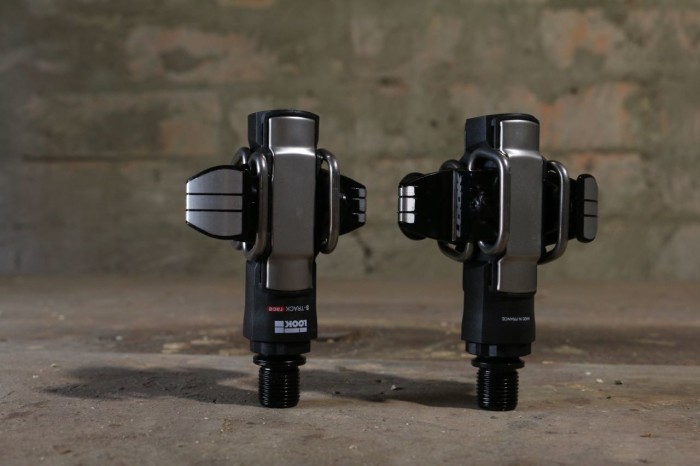Look have been in the clipless pedal game for a long time, pioneering the technology thanks to their prowess with ski bindings. Although they are more well-known for their road pedals than their mountain bike pedals, the Look S-Track pedals offer a few advantages to other pedals on the market, which is why I wanted to test a pair for myself.
But first – why was a I looking for different pedals?
I have used Shimano SPD pedals since I started mountain biking with some minor intent, since 1998. The PD-M535 were a reliable pedal whose bearings just spun and spun. While I used Time ATAC for a short time, and loved the float and bright colours, I then went to Crank Brothers, as most people did in the early 2000s. They were light, cool and new. But I also broke about 3 pairs, and have never felt the need to go back to the experience of overly frequent servicing, fast wearing cleats and broken pedals.
So I stuck with Shimano, through the excellent M970 XTR pedal, and then newer XT and XTR variants which just don’t stand up like the M970 did, thanks to the smaller bearings. While the pedal isn’t hard to service, they do tend to require it with some frequency. I did ride more recent Time pedals again, and quite enjoyed them, save for the damage to my shoes, but neither Time nor Shimano had the feel that I wanted when in the pedal. As a user of Shimano SPD SL pedals with fixed cleats on the road, I wanted a more solid engagement, not ‘float’ which just felt sloppy or like cleat was rattling around in the mechanism.
Speaking to riders using the Look S-Track – this was the pedal to try. They had a solid feel when engaged, and as a bonus, you could get a removable cage to turn it into a great ‘trail’ pedal.
Out of the box, one thing that stands out is the weight – the Look S-Track Race pedals were 299g on my scales, which is pretty good in my books. The entry level pair are just about the same, but I was hoping that the improved materials on the Race model would last longer. Without a set of both, that will be purely guess work.
That’s 299g, not 244g.
What also stoof out was the stack height. There is a fair bit of talk, and evidence, that lower stack heights in your shoes and pedals will improve power transfer. It helps with cornering clearance too. Compared to the very low Shimano XTR pedals, you really throw caution to the wind with the Look pedals. They sit high and proud.
The two retention bars do seem to be in the way of rocks and such – but they are actually protected very well. The design of the pedal does allow mud to limit interference, but of course that’s not the whole story.
The cleat setup is a little more complex. The cleats come with shims to tune the interface between the sole of your shoe and the pedal, so it will feel how you want it too. I wanted it pretty snug and secure, so I used one red (thin) shim.
With the cleats fitted, and a trial in the backyard, it was a moment to rejoice. There was not rattling cleat in the pedal sound, it was just a powerful, secure feeling. Exit was clean, and entry was pretty good, just a slightly different feeling to Shimano that would take a little bit of getting used to. The pedal just doesn’t seem to catch the cleat in the same way as a Shimano pedal does. After a few months use, I’m happy with it, and not looking to change back. But they don’t have the same ‘hit and engage’ feel as a Shimano MTB pedal does. But once I’m in, they do feel far better. And while there is plenty of float, it’s not of the ‘flapping in the breeze’ variety that I don’t like.
But about the cleats and shims… you really need to get this right. The first sue in pressure with these pedals was the Swiss Epic Prologue, which was quite muddy in the second half. While the pedal sheds mud, shoes and cleats still collect it remarkably well. So with just one dab in heavy mud, I could barely get back into the pedal. With such a firm push required to get in, thanks to using just one thin shim, I wasn’t able to engage once my shoe was clogged with mud. Even hitting the edge of my shoe against the pedal, it was barely enough to get back in. And when I did engage, it was far harder to get out again.
So one of the biggest benefits of the pedal is also it’s achilles heel – for me anyway. I’ve tried using a ticker shim, and the performance for getting in and out in mud is great – but the super secure feel diminishes. Living in Queensland, I’m accepting the mud difficulty. As while the pedal itself is virtually mud proof, the sole of my shoe and the cleat are not. This is a personal setup choice, and likely to be different for anyone else.
Bearing durability has not been tested yet. The pedals did have minor play in the axle out of the box, which is pretty suspect. But it hasn’t become any worse in the first 3 months of use.
If you’re after a secure feeling pedal, that is light and reliable – this is a great choice. But if you want low stack height, go for XTR. If you want super mud clearing ability, try Crank Brothers and schedule your maintenance. These weren’t a small investment, but one that I’m happy I have made.

